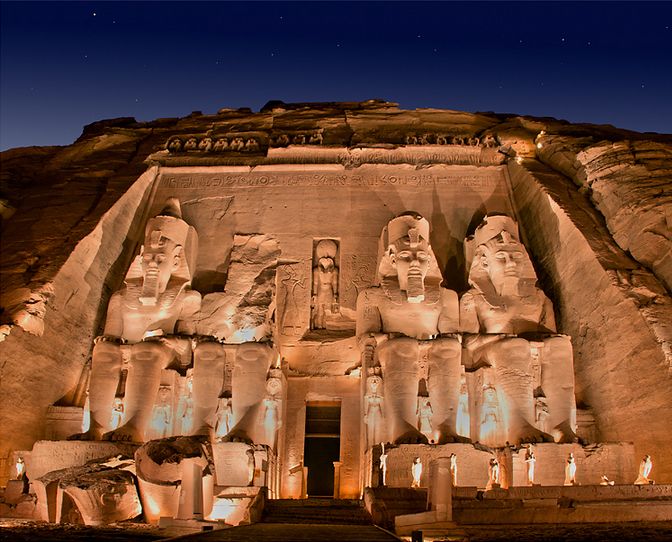- Sommerschlussverkauf! Sparen Sie bis zu 15%

The Abu Simbel Temples, carved into the mountains of southern Egypt, stand as a testament to the grandeur and ambition of Pharaoh Ramses II. These magnificent temples, dedicated to the gods and to Ramses II himself, are among the most impressive monuments of ancient Egypt. Join us at Marvelous Travel as we delve into the history, significance, and awe-inspiring beauty of the Abu Simbel Temples, a UNESCO World Heritage site that continues to captivate visitors from around the world.
Ramses II, also known as Ramses the Great, ruled Egypt for 66 years during the 19th Dynasty (1279-1213 BCE). Renowned for his military prowess, administrative achievements, and extensive building projects, Ramses II left a lasting legacy through monuments that celebrated his reign and honored the gods.
The Abu Simbel Temples are a marvel of ancient engineering and artistry. The Great Temple, dedicated to Ramses II and the gods Amun, Ra-Horakhty, and Ptah, features four colossal statues of the pharaoh at its entrance, each standing at 20 meters (66 feet) tall. The smaller Temple of Hathor, dedicated to Queen Nefertari and the goddess Hathor, showcases six statues at its facade, with Ramses and Nefertari depicted in equal size, a unique feature among Egyptian temples.
One of the most fascinating aspects of the Great Temple is its precise alignment with the sun. Twice a year, on February 22 and October 22, the rising sun penetrates the temple’s sanctuary, illuminating the statues of Ramses II, Ra-Horakhty, and Amun, while the statue of Ptah, associated with the underworld, remains in shadow. This solar phenomenon demonstrates the advanced astronomical knowledge of the ancient Egyptians.
The temples of Abu Simbel were originally carved into a mountainside near the Nile River. In the 1960s, the construction of the Aswan High Dam threatened to submerge the site. In an extraordinary engineering feat, the temples were meticulously dismantled and relocated to their current location on higher ground. This UNESCO-led project preserved these cultural treasures for future generations to admire.
Inside the temples, visitors can marvel at the intricate reliefs and carvings that adorn the walls. These artworks depict scenes of Ramses II’s military victories, religious rituals, and offerings to the gods. The vibrant colors and detailed craftsmanship provide a vivid glimpse into the life and beliefs of ancient Egypt.
The Abu Simbel Sound and Light Show is a captivating experience that brings the history of the temples to life through dramatic lighting and narration. The show, presented against the backdrop of the illuminated temples, recounts the story of Ramses II, the construction of the temples, and their relocation. This evening event offers a magical way to experience the grandeur of Abu Simbel.
The Abu Simbel Temples are located approximately 280 kilometers (174 miles) southwest of Aswan. They are accessible by road, air, or as part of a Lake Nasser cruise. Many visitors opt for a day trip from Aswan, which includes a scenic drive through the desert.
The temples are open daily from 6 AM to 5 PM. Tickets can be purchased at the entrance, with discounts available for students and children. The Sound and Light Show requires a separate ticket, which can be purchased on-site or through Marvelous Travel.
Enhance your visit to the Abu Simbel Temples with a guided tour from Marvelous Travel. Our expert guides provide detailed commentary on the temples’ history, architectural features, and cultural significance, ensuring a comprehensive and enriching experience.
The Abu Simbel Temples offer a breathtaking exploration of the architectural and artistic achievements of ancient Egypt. At Marvelous Travel, we believe that visiting these temples provides a deeper appreciation for the legacy of Ramses II and the ingenuity of the ancient Egyptians. Don’t miss the opportunity to explore the awe-inspiring Abu Simbel Temples and uncover the stories behind their creation and preservation.